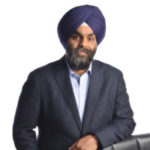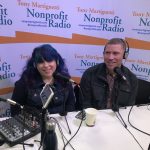
I love our sponsors!
WegnerCPAs. Guiding you. Beyond the numbers.
Cougar Mountain Software: Denali Fund is their complete accounting solution, made for nonprofits. Claim your free 60-day trial.
Turn Two Communications: PR and content for nonprofits. Your story is our mission.
Get Nonprofit Radio insider alerts!
Listen Live or Archive:
- On Fridays at 1pm Eastern: Talking Alternative Radio and tune in
- Listen to the June 26, 2020 archived podcast
My Guests:
Krystal Ramseur & Graziella Jackson: Improv For Culture And Creativity
A performer and a board member from Washington Improv Theater teach us how improvisation can make your team more creative, confident, supportive and successful. They’re Krystal Ramseur and Graziella Jackson.


Karen Graham & Dan Getman: Tech Policies
Karen Graham and Dan Getman want to help your staff avoid scams, malware and inappropriate data handling. Might you have employees using personal phones or computers for work? You especially need to listen. Karen is with Tech Impact and Dan is at MANNA.


Top Trends. Sound Advice. Lively Conversation.
Board relations. Fundraising. Volunteer management. Prospect research. Legal compliance. Accounting. Finance. Investments. Donor relations. Public relations. Marketing. Technology. Social media.
Every nonprofit struggles with these issues. Big nonprofits hire experts. The other 95% listen to Tony Martignetti Nonprofit Radio. Trusted experts and leading thinkers join me each week to tackle the tough issues. If you have big dreams but a small budget, you have a home at Tony Martignetti Nonprofit Radio.
Get Nonprofit Radio insider alerts!
Sponsored by:
View Full TranscriptProcessed on: 2020-06-26T21:40:43.888Z
S3 bucket containing transcription results: transcript.results
Link to bucket: s3.console.aws.amazon.com/s3/buckets/transcript.results
Path to JSON: 2020…06…495_tony_martignetti_nonprofit_radio_20200626.mp3.390340932.json
Path to text: transcripts/2020/06/495_tony_martignetti_nonprofit_radio_20200626.txt
welcome to tony-martignetti non profit radio [00:02:01.54] spk_1:
big non profit ideas for the other 95%. I’m your aptly named host. Oh, I’m glad you’re with me. I’d be stricken with UV itis if I saw that you missed today’s show. Improv for Culture and Creativity. A performer and a board member from Washington Improv Theater Teach us how improvisation can make your team more creative, confident, supportive and successful. They’re Crystal Ramsar and got Cielo Jackson. That’s part of our 20 and TC coverage. Also. Tech policies Karen Graham and Dan Getman want to help your staff avoid scams, malware and inappropriate data handling. Might you have employees using personal phones or computers for work? You especially need to listen. Karen is with Tech Impact, and Dan is at manna. This is also part of our 20 and TC coverage on tony steak, too. Thank you were sponsored by wegner-C.P.As guiding you beyond the numbers. Wegner-C.P.As dot com by Cougar Mountain Software Denali Fund. Is there complete accounting solution made for nonprofits tony-dot-M.A.-slash-Pursuant Mountain for a free 60 day trial and by turn to communications, PR and content for nonprofits, your story is their mission. Turn hyphen two dot CEO here is improve. Brilliant. Yes. This is the lackluster host that you’re stuck with. Here is improv for culture and creativity. Welcome [00:02:52.34] spk_3:
to tony-martignetti non profit radio coverage of 20 NTC 2020 non profit technology conference. You know, the conference had to be canceled, but, you know, we’re persevering. Virtually sponsored a 20 NTC by cougar math and software Denali Fund. Is there complete accounting solution made for non profits? Tony-dot-M.A.-slash-Pursuant Mountain for a free 60 day trial, I guess now are Crystal Ram sore. And Graciela Jackson Crystal is chief administrative officer at the National Council of Negro Women. Gretz Yella is partner and CEO at Echo and Co. Um, Also, Crystal is a teacher and performer and board member at Washington Improv Theater, which is most relevant to what we’re talking about today. And Graciela is a board member at UIT Washington and breath theater. Crystal Graciela, Welcome. [00:02:56.54] spk_4:
Thank you. Glad to be here, but [00:03:29.90] spk_3:
have you? I’m glad we could work this out. I’m glad you reach well and safe in our nation’s capital area. They were both in D C D c. Proper. Yeah. Yep. Your ah ntc topic is improv. Saves the non profit boosting culture and create team creativity. Um, that’s interesting, because I am on, uh, how does it do that? Oh, even though on, uh, even though I turned to my, uh, even though I’m on Eric’s airplane mode because zoom because we’re special way all the fatal started a few minutes early. That’s why [00:03:36.28] spk_4:
it’s asking you to improvise. It’s very timely and relevant. [00:03:46.04] spk_3:
Thank you. And I didn’t do a very good job Called out for what it was. I didn’t even, um so, Crystal, let’s start with you. What? Um why? How come, Ah, improvisation can help us out creatively. Effectively. Team building. What? What about it? [00:03:57.70] spk_2:
Yeah, So I think one of the biggest things I love about improv is it really pushes you to stay present and stay in the moment. And because in what we’re working with right now and then creating together. So I think a lot of times in business or you’re in meetings and you’re having thoughts about ideas and people like, Well, we tried that idea last year, didn’t work, which was 10 years ago, didn’t work, or if we do that And the people are already thinking of reasons why we can’t do something but right. Improv focuses on No. We’re working with what we have right here in the present. And presently this is this is these are the parameters. Why couldn’t we try this? And the number one rule in improv is Yes. And so if we say yes, how do we then take that idea and continue to build something together? And I think when you just those principles right there make for better working community. [00:04:58.88] spk_3:
Great yellow. There’s also a confidence building, right? You walk out on the improv stage. I’m taking the example of just two people. You know, their team exercising everything. But you walk out with just two people. One of you has an opening line, and you gotta build a sketch around it for the next 4 to 5 minutes around that fine. And the other part, neither. And the other person doesn’t know what that opening line even [00:06:27.97] spk_4:
is. Yeah, I It’s interesting. I think there’s an incredible freedom that comes from what Crystal was saying. Presence. Because if you are able to, and I think what improv teaches you to do to just respond to what’s given to you in the moment and say, like, I don’t have to do this huge thing right now. I don’t have toe entertain this gigantic audience. All I have to do is take this thing that my partner contributed as a gift and build on it. You find yourself being able to create things with a lot more freedom with less, much less of the fear that comes from, like worrying about the benefit of your contribution or whether or not you have the perfect or the right answer. And I think one thing that I learned just in taking trainings on this and being a part of the board is you have to be as willing to abandon what you’ve contributed and contribute something new and just be constantly moving forward with creative ideas rather than getting stuck in the mindset of judging what you just created. So it’s kind of separating your creative brain from your critical brain and super important. [00:06:29.38] spk_3:
That’s interesting that, yeah, you don’t have time to self censor. You’re you’re in front of an audience. You heard a line and you’re supposed to build on it. [00:06:51.05] spk_4:
Yeah, and there’s something exciting about the active discovery like When you really invest in that thing that you’re building together, you’re probably going to find something that’s even more interesting and funny and entertaining and no crystal. You do this all the time and some of the exercises that you’ve lead, but it’s it’s sort of being willing to just keep going because you’re gonna build something bigger and more exciting and more powerful. If you just don’t stop yourself [00:07:07.52] spk_3:
and crystal, you keep going. Regardless of what the audience reaction is, right, you don’t you don’t just walk off stage when lying. Number two, you know, didn’t get a huge laugh or wasn’t even supposed to get a laugh. And then you just walk off stage, Say off, you know, screw it. [00:07:34.63] spk_2:
No. And you’re in this together with your scene partners. I think I love that like we’re out here. Wow, we made this choice to be aliens in the West. Didn’t you know what? That’s where we’re at? And we got to commit to this and we just commit harder to it right and see where it leads. [00:08:04.28] spk_3:
Robe use that aliens and robots in a cornfield way have to build a robot family. The two of us. Yeah, just, you know, whatever. All right. So, uh, Crystal, were you gonna be doing exercises if you had had the opportunity to do the session? The usually so games or anything? [00:08:07.00] spk_2:
Yep. Yeah. So we had a feeling good today, So we had a list of games. Really? Toe kind of show. Ah, little bit of intro into improv. Doing some? Yes. And, um What, Graciela has the list? [00:08:21.55] spk_4:
Yeah. Yeah, I couldn’t pull it up. I think it started with it, I think, [00:09:00.63] spk_3:
instead of instead of reading the list. Yeah. Never doing improbably, don’t just talk about what we’re gonna do, right? Sit around like a board, Actually, actually, do we actually dio not talk about? Wouldn’t it be funny if we did this? This would be fun to do that, and so we never do that. So how are we going, Teoh doing improv, the three of us that will, um, some kind of game that will bring home, of course, the lessons that we’re trying to learn in terms of culture, team building, confidence, creativity, efficiency. What are we gonna do? I’m putting you on the spot deliberately. [00:09:35.34] spk_2:
I don’t want you want Can we plan the vacation? Yes. Like point of it was just telling us. So let’s do this. So I plan a vacation, and we’ll planet with the three of us will go. I can start and we go from me to Graciela to tony, and then we’ll just keep circling like that. So the way we’ll do it is we’re trying to plan a vacation for the three of us. The first line of the sentence when you respond to someone, has to be Yes. And and then you can pushing forward from there. Go. So, uh, wow. I’m so glad that were doing this vacation. I really think we need to go somewhere warm. [00:09:47.04] spk_4:
Yes, and we need to go somewhere warm immediately. [00:09:56.44] spk_3:
Yes, and we can. I mean, I’m already packed. Let’s, uh let’s go. I mean, I love the Caribbean of either. Have you been to the Caribbean? [00:10:04.24] spk_2:
Yes. And I’ve decided I’m just gonna by all of us a new wardrobe while we’re there. So I don’t even aggressively not back. Didn’t even need to pack. Let’s go right now. And I say we have margaritas as soon as we get there. [00:10:16.78] spk_4:
Yes. And after the margaritas will party a little bit, and then we’ll go snorkeling. [00:10:23.59] spk_3:
Oh, yes. And, um, since I’m not bring any clothes now, I’m just gonna go snorkeling naked. [00:10:29.64] spk_2:
Yes, and we’re gonna feel the water, and I bet will make friends with dolphins. Yes, and everybody [00:10:37.67] spk_4:
will get excited about what we’re doing, and they’ll want to join as well. [00:10:47.90] spk_3:
Oh, yes. And this party is just gonna get even bigger. Um, we Let’s invite more folks, not just the three of us. [00:10:50.54] spk_2:
Yes. And let’s blast this to everyone that we’ve ever met and tell them Jump in the water with us. And let’s make this the new party. Yes. And let’s see if [00:11:03.59] spk_4:
we can get a boat so we can take this party toe other islands. [00:11:17.27] spk_3:
Oh, yes. And while we’re going between the islands, we could be fishing. There’s, like, weaken dive off the boat on our way to the other island. So the the boat is part of the is part of the [00:11:20.44] spk_2:
fun. Perfect. There. We owe that. I love that activity. [00:12:28.40] spk_1:
It’s time for a break. Wegner-C.P.As, I said a couple of weeks ago. This shit is hitting a fan fast. It’s still coming down at us. That’s Ah, that’s a mixed metaphor, really, because if it’s hitting the fan that’s not coming down, it’s being blown at us, Uh, coming fast, still raining down on us. It’s coming, blowing, it’s blowing on us. It’s hitting the fan and it’s still blowing on us. That’s better. Anyway, this shit is there. However, it got to us recovered in it. Wegner has a new free webinar on July 1st to explain the latest on paycheck protection program loan forgiveness. You know you need to apply for it. You don’t get it automatically now. What wegner explains to register goto wegner-C.P.As dot com Click Resource is now back to improv for culture and creativity with Crystal Ram sore, a gutsy Ella Jackson. [00:12:43.74] spk_2:
What we do sometimes when we do it will start the activity bus, saying you first have to plan a vacation by doing no because, yeah, you say No, but and you do it that way or you say no, because and you try to plan a vacation and it’s so hard, right? Because every time you you threw out an idea like let’s get a boat, the person’s like No, because I’m scared of a boat. And so you realize you don’t do anything. You’re likely [00:12:57.88] spk_3:
roller. The idea is becoming someone’s muller and harder to deal with. Uh, instead of broadening. Okay. Um right. So, crystal, what we learn from what we just did in a couple minutes [00:13:09.84] spk_2:
when we learn, uh, what happens when we all, like, let ourselves be creative and have the wildest thought that we’ve ever had? Um, you know, if you just were in a meeting and we wanna figure out how we increase this sales numbers, what have Let’s just throw out the wildest thing we’ve ever thought And let’s play with it for a little bit and let’s not shut it down right away. Let’s play around with this idea and see what we can come up with together. [00:13:39.24] spk_3:
Okay? That’s the other anything you want you want to add? [00:14:17.63] spk_4:
Yeah, I think that it’s really, really important because I think we’re where organizations, especially non profit teams, get stuck most often because they’re in fast paced, scarce resource environments where you know every dollar you spend on idea is really important. I think that bringing this technique in and allowing yourself some space to say, Let’s just separate the created creation of ideas from the judging of ideas and the vetting ideas and try to get to a place where we are envisioning what’s possible because it’s counter to our culture and and has to be in some ways to be to do that. And so it just allows you toe get past. You know, the 1st 3 or four ideas which are always the ones that are more familiar, safer, probably more likely to be accepted and really set those aside and push yourselves to think in new ways about challenges It doesn’t. There’s no risk in spending the time coming up with ideas. And if you can use these tools to get everybody feeling comfortable on open and curious and creative, and you know you can design the collaboration really well and bring games into it, you end up with this whole inventory of possibilities that then you can take into a more critical process and evaluate and put things like metrics and objectives around them. But chances are people will feel more included in the process. They’ll forget that time is passing cause they’ll have fun. They’ll feel like the quality of their ideas is better, and they’ll feel like they accomplished something that then they can take and turn into something better. [00:15:19.64] spk_3:
You go and you have some rules around this, right? Like, yeah, we’re not. We’re not judging. We’re not saying that idea sucks. No, it’s it’s, you know, sort of classic brainstorming. Yeah, it’s just the free flow of ideas. [00:15:33.17] spk_4:
Yeah, the one that that Washington and profit teacher a Washington improv theater teaches us is definitely the concept of yes and that Krystle mentioned. There’s also the concept of Let go, and that’s about just removing your bias and your preconceived notions and the things you’re bringing into the room with. You just let go of all of those notice everything because probably the things that you’re ignoring also have possibility. And we’re so used to not letting go and then Onley noticing what’s important to us. And then I think the last one is used everything. It’s sort of whatever is brought into the room. See if you can apply it to something, even if it’s toe honing. You know your idea. Been proving your idea? I don’t know. Crystal, did I represent those well enough? [00:16:18.21] spk_2:
Absolutely no, I think, especially when you talk about using everything. That’s the other part about that exercise that I like so much. It’s forcing you to listen to what the person before you just said. Really listen to what they say, because you have to build off of it. So instead of just you’re already thinking of your idea, you can’t think of it yet. You need to wait to hear what that other person says. [00:16:53.94] spk_4:
Yeah, there’s, Ah, there’s, I think like when you think about what? How work is changing right now. In addition to needing to be open, more collaborative, more agile, getting things out the door faster with less resistance. A lot of that has to do with also being able to take a systems view of things. And if you’re not actually using these techniques and these approach to build an understanding of the scope of what you’re dealing with, so if you’re thinking about like social change or environmental change, the idea is you have tow, envision the system, and if you spend 30 minutes sort of saying this is important No, it’s not. This is important. No, it’s not versus Let’s spend the next hour identifying everything about this system that’s important. Then you can start to, you know, group those things and come up with plans around those things that’s incredibly helpful for strategic planning [00:17:32.74] spk_3:
or just everything. Not everything that’s important. But everything that impacts. Yeah, that’s around this system. Outside influences, our own influences, our own biases, everything that impacts our work. Yeah, Neville, categorize what we have control over what we don’t What’s what’s significant? What’s thus significant? [00:18:52.83] spk_4:
Yeah, way had this thing. This organization we’re working with is a large labour union, and they had were working with them on rethinking their Web presence, and they have more than 30,000 pieces of content across lots of websites. And our content strategist did an exercise Gina Marie condo, the Netflix show about just like taking everything out of your closet, putting it in a pile, going through it, cleaning it until you’re everything around you brings you joy. I’ve never seen it, but she created this exercise, which was more or less improv that didn’t get to Let’s talk about all of the content that you’re gonna be losing from this Web presence. Let’s spend time sort of improvising what it’s like to move out of a house. What do you do in what order? And she went through this really detailed activity where people built the experience of what it’s like to move a house, and then they designed that whole process in system. And then they basically compared that to what it’s like to cleanse 30,000 pieces of content. And people immediately understood the process because they are familiar with this challenge of needing to move your house if you’ve been through that before. And so they forgot that what they were doing was planning change management. All they did was Plant was like We’re planning something familiar to them and then borrowing from those concepts to accomplish this big, scary thing that nobody wanted to dio. So I think that’s the power of of this work and creativity and adapting the exercises to your space [00:19:58.82] spk_3:
Crystal. Let’s talk some about, um, the team building. Like I was saying earlier, you know, you walk out on improv stage two of you. One of these got an opening line from, ah, word that an audience member throughout, and you’re you’re each counting on each other. Yes, and and follow all the other principles of bring everything in that you’ve got. And that’s not censoring yourself, etcetera. But you’re building on each other. It’s confidence building and team building s over the individual and for the team of two, or could be a bigger team. Talk some about that. How improv helps helps that way around team team cohesion. [00:22:03.74] spk_2:
Yea, I think it also it helps. Trust is the other part of it as well that I think that builds. Um, one of the I worked with a group where we on organization and they’re one of the issues was they had a whole issue around hierarchy. They just hired a bunch of people and let go of a bunch of people. And a lot of people didn’t feel like their work really mattered or that their voice mattered. Um, and so they weren’t sharing their ideas and meetings, and they actually brought a group of improvisers to come and do a whole workshop and the all the exercises that we did, we’re focused on know everybody has a piece in what we’re doing, and it’s vital, and we need everyone to fully, um fully do their work, and then I need to fully accept what you’re giving me, right? So, yeah, if it were walking out on that stage is a blank stages. I always tell people there’s there’s nothing there. So if I say we’re aliens in Oklahoma and you’ve gotta agree that yes, we’re aliens. What does that mean? You know, we can build Bring that into this, um, you got agree where we are, and then part of it is the two of us that are on the stage. But then anyone else on the team, right? Whoever’s gonna edit that scene, whoever is gonna ah, wipe the scenes of them were out of their everybody. That is a part of this team, whether they’re on stage right now or not, are still a part of what’s happening and have a piece to play and how we do this. And I think that’s that same thing. When you talk about an organization, right, you have people that are clearly gonna be the ones to make that final decision. But so everyone has some role that they need to play. Um, in order for everyone to feel that value to and that. And a lot of the work that we do is building that trust that I know I could go out there and say something to you. And I know you’re gonna listen to me. You’re gonna pick it up, and we’re gonna build that together and not you’re gonna shoot my idea down and say we’re not aliens in Oklahoma were just two people stuck in North Carolina. You know what else [00:22:19.64] spk_3:
can listen to do crystal? Maybe another exercise that they can practice? Oh, are you know, so that they can sort of see the benefits of reap the benefits of the improv principles. Uh, okay. You don’t have the benefit of actually doing the exercises. What else? Ah, what about some of the game folks can play to get some benefits? I get either Christmas or either one. [00:23:38.94] spk_4:
Well, I can as crystal you’re thinking about some. I think they’re simple. Exercise weaken dio, I think Teoh address very common feelings. One is just feeling blocked or feeling blank when someone asks you a direct question. Because if you’re at all you know, if you don’t think that way, or if you don’t want to take center stage three of a fear of public speaking. The only way to overcome that is to practice, and you can practice in really small ways. So one thing we do with most organizations we go into and and run creative workshops are very simple word exercises where you have a group of people around the circle and you just say a word and you go around the circle on the person next to you says the first word that comes to mind. And it’s about listening and learning about yourself when you’re trying to anticipate what to say because you want to perform well versus really just being in the moment and offering a word. So if I were to say crystal, if Aiken borrow you for a minute and say, um, the word blue [00:23:42.39] spk_2:
and I’m sorry and you want me to do [00:23:44.09] spk_4:
Oh, yeah, yeah, yeah. Does. And I’m putting you on the spot. Um, yeah, I just like to say the word first word that comes to mind I felt so yeah. [00:23:56.64] spk_2:
Um, green, [00:24:07.24] spk_4:
uh, read blood. Ah, Death church. Um, community. [00:24:13.74] spk_2:
Ah, in breath. Fun. Uh, um rafts, [00:24:55.98] spk_4:
um joy. Family well and so on and it’s It’s funny because even this exercise, the first time we do it with a group of people, let’s say more than five people. Everyone gets nervous and we’re not really doing anything. We’re just saying words that come to mind based on what somebody else said. So if you can just do that a couple times and talk about why is it you know, a little bit of self awareness? Why is it that we feel uncomfortable in the moment? What’s operating behind that is a that fear of contribution. It’s kind of the fight flight freeze impulse when you’re on the spot. So I think and there’s tons of these games available online to use as warm up activities or team building activities. I think we we may have or are gonna have some on our website, which is echo dot Co and, um, and it’s just really important to get in the habit of not just jumping into a meeting, but offering some of these activities to help get a sense of presence, a sense of what we call psychological safety, which is everybody feels like they are open to contribute at without embarrassment or without hanging criticism without judgment. Yeah, without judgment. That’s yeah. [00:25:49.09] spk_3:
So there’s some resource. Is that eco E C h o dot co. Yeah. Yeah. Okay. Okay. Um, that’s crystal you. It’s Ah, bookend. You opened up. Why don’t you just take us out with some final thoughts? Whatever you have, you want clothes [00:26:26.52] spk_2:
final? That’s OK, so I do. But I do want to share one of my other favorite exercises since we were just talking about it. And I love this one because I taught improv with Children teaching probably people who have taken classes or have actually done a teaching profit, a homeless shelter as well. But my favorite exercise is panel of experts, and it’s so fun because anybody can contribute. And you immediately when we talk about building that trust, building that team, it’s you can have really as many people. But you know, at least three, maybe like 3 to 6. [00:26:31.35] spk_3:
Let’s plan. All right, we got we’ll go a little bit longer. Like a [00:26:31.66] spk_6:
minute and 1/2 [00:26:33.33] spk_3:
or so What? [00:27:30.49] spk_2:
So so panel of experts, each of us, the three of us were doing like a Ted talk here where we have this audience and we pick and you can pick just a Monday ING thing anything. And then we’re gonna be the experts of that thing so we can go around in the same order that we did. And we’re just gonna be It’s as if we’re like I said, giving a Ted talk about whatever it is that we’re talking about. So because I’m just been looking at radio screen, I’m gonna say, um, we’ll talk about that bookshelf behind Graziella. So thank everyone for being here today. Um, we have built the perfect bookshelf for any office. This bookshelf, which was developed by, um, Dr Alvin Smith, um, really made it so it can fit in any area that you needed to fit. It actually adapts to the office to a closet to a bathroom. Really? Wherever you need this book shelf, it morphs into what you needed to be. Graziella, could you talk a little bit about the development of that? Yeah. Yeah. [00:27:46.99] spk_4:
So you know, when we were conceiving of this perfect bookshelf, I think what we first asked was, you know, what is it that a bookshelf means to us through the journey of our life? You know, you start off as a young person, you are in your space. You’re looking at a blank wall, and that wall doesn’t mean anything to you. But if you fill it with something that can hold your treasures, your books, it facilitates the space of imagination and really opens up who you are as a person. So it really is more than a bookshelf. It’s a place for you to showcase the aspects of who you want to become through life and also your identity. So that’s kind of where we started. We want it to be exciting. We wanted people to say, That’s not a bookshelf. That’s me. And so that’s kind of what we wanted to bring to the creation of this. Tony, do you want to talk a little bit about kind of how you’ve seen people respond to this bookshelf? [00:29:59.44] spk_3:
Well, I’m afraid we’re out of time. We Oh, no, I know that’s a violation. Um, yeah, we we brought this. You know, we brought this again as you were saying, Graziella to to be much more than just the physical object. And we’ve We’ve We’ve watched people interact with it. We’ve of course, we’ve surveyed them formally. We’ve actually been observing the way people use the bookshelf the way they interact with it. There’s the There’s the basket feature on the second shelf. That’s that’s pretty much open. That’s open. Anything you want it to be. You can put your junk in there. You can organize it carefully. Or you could put your knitting needles and and balls in there. We’ve seen that, too, of course. The top. We’ve seen people interacting, being more for organizational, since that’s the That’s the part that shows, even if it is in a closet like crystals, saying this could work in a closet as well as a wall. But if it isn’t a closet, you know the top shelf is what people see them first. So they we’ve seen people organized the top better. The middle has been more, um, more personal on. That’s been exciting to see how people have reacted to the different components that we engineered on a very personal, very personal creativity kind of levels. [00:30:01.10] spk_2:
Yes, sin tony, all of your pictures of your bookshelf. [00:30:09.40] spk_3:
Alright, Alright. So what? We were out Not no, no censorship building on what others contribute. Taking everything in What? You’re an [00:30:16.79] spk_2:
expert in it, right? So speaking with confidence about whatever the topic is so right, if we were just in a room, a topic, we could have picked anything. And we are experts on that topic. So you’re speaking with confidence and and still building this together. Mm. [00:30:36.84] spk_3:
Okay. Okay. Um, let’s leave it there. Do we do about that? Except do we pull everything out that we can about that exercise? Because I don’t want to do it for fun [00:30:43.96] spk_2:
thing. The only other thing [00:30:46.57] spk_4:
I’ll say is just opportunities to replace competition with trust Trust in celebration. I think that’s kind of the name of the game. Really helps to just celebrate what people are bringing to the table and use that to inspire better thing. [00:31:18.14] spk_3:
And that trust to each of you said no said I didn’t. I wasn’t on the wasn’t on the hot spot for this. But you know, each of you lead with lead the next person with a question, your confidence that the person is going to take it on and is not gonna object or or fumble or, you know, but But it carried further. Okay. Excellent. Thank you. very much crystal ramps or chief administrative officer. National Council of Negro Women got CEO Jackson partner and CEO of Echoing Co. And both deeply involved with with the Washington Improv Theater. Thanks so much for being with me. Thank you. [00:31:38.02] spk_4:
Thank you, Thank you. Thanks for Stoke tony. [00:31:38.61] spk_3:
Thank you for being with tony-martignetti non profit radio coverage of 20 NTC. [00:33:10.18] spk_1:
We need to take a break. Cougar Mountain software, Their accounting product Denali is built for non profits from the ground up so that you get an application that supports the way you work that has the features you need and the exemplary support that understands you. They have a free 60 day trial on the listener landing page at tony-dot-M.A.-slash-Pursuant non. Now it’s time for Tony’s take two. Thank you. Um, thanks for being with the show and staying with it through Corona virus and recession and protests against racism. Um, I’m I wanted to keep producing the show. I mean, there’s no there’s no stopping the show. The show has got to go on, but, uh, all the more I think, you know, just because things have been so tumultuous since what, roughly march 23rd or call it mid march. Um, so much confusion change, uh, you know, new routines. The show has got to continue. It has got to be some things that we just can rely on. They’re just gonna be there. And non profit radio is one of them. And so I insist that, uh, not that not that I was thinking about postponing are going on hiatus. But it’s just three assure that Ah, some things remain unchanged. Remained constant. You can count on them, and non profit radio was one of them. And thank you for being consistent, loyal listening audience. Actually, it’s uptick ta little bit. It did like in April and may, you [00:33:30.85] spk_3:
know, more people spending a lot more time at home, right? Doing everything at home [00:34:10.00] spk_1:
from exercise to maybe more podcasts. So, um, thank you. So I’m I’m glad and gratified that, uh, audience hasn’t declined. You haven’t gone anywhere. The show still has value for you. That’s very gratifying for me. I thank you for sticking with the show. Still listening, and I’m just glad that you’re still getting good information from it. So thank you. That is Tony’s. Take two. Now it’s time for tech policies with Karen Graham and Dan Getman. [00:34:42.03] spk_3:
Welcome to tony-martignetti non profit radio coverage of 20 and D. C. That’s the 2020 non profit Technology Conference were sponsored at 20 NTC by Cougar Mountain Software. With me now are Karen Graham and Dan Getman. Karen is director of education and outreach at Tech Impact, and Dan is senior manager of donor relations for manna. Karen Dan. Welcome back, Teoh. Tony-martignetti non profit radio. Well, for you, Karen. Dan. Welcome. [00:34:48.37] spk_6:
Uh, thank you. [00:35:32.51] spk_3:
Glad to know that you’re each well and safe Dan in Philadelphia. Karen in Minneapolis. Good to know. I’m glad we could work this out. Your conference topic is establishing tech policies to protect your non profit can. You and I have talked about tech policies in the past and and other things that are, uh, when you were with idea where we’re on the surface boring. And you were happy to call them that, but nonetheless important to your non profit. So would you mind doing the same? Explaining the the importance to what could sound like something very dull? [00:36:08.17] spk_6:
Sure. Well, I mean, regardless of what kind of situation we’re in, we all know that there are good people that make bad choices. And so having some policy guidelines to help people to anything twice about those choices, um, should provide some guidance for them, as is helpful but also having some clear consequences, I guess, in place or responses when people do make bad choices. That’s also important to know how you’re going to respond If somebody makes a mistake now, especially, I think nonprofits are feeling this in the right. Now, as we’re recording, we’re in the midst of the Corona virus outbreak and ah, lot of dumb profits have gone to remote work. And so they are, I think, thanking their lucky stars or they’re good judgment if they already have developed really good policies for remote work and use of personal devices and things like that. And if they haven’t done that, they’re scrambling right now to try to figure it out. [00:36:35.50] spk_3:
What are some of those bad choices that you’re talking about? [00:36:54.98] spk_6:
01 of the things that comes to mind immediately is ah, a kind of choice that will lead to a security vulnerability. Um, you know, just say, sharing data that is his private that contains personally identifiable information with people that really don’t need to have that information, um, downloading it onto a home computer, things like that, Like those kinds of choices can really make an organization vulnerable to that data getting into the wrong hands, Um, or to like, passwords and system access getting into the wrong hands. And I mean, I’m sure we’ve all seen the consequences of that. Um, I have some data on that. They’re the average cost of a data breach, according to a 2019 survey was almost $4 million for a data breach and on profit. They’re just as vulnerable to that, if not more so. Ah, compared to therefore profit piers. [00:38:00.59] spk_3:
Yeah. Yeah. Oh, yeah. Certainly we think about organizations in the health care’s our healthcare arena. But even outside health care, there are dates of birth, their credit card numbers. Um, other personally, you might have social security number for some reason. Um, it’s all that personally identifiable information. Oh, [00:38:00.98] spk_6:
and all of that can compromise people’s privacy. And it also can make an organization really vulnerable to ransomware attacks where the hacker threatens to release that information to the public, or, um or misuse it in some way that can really destroy the organization’s reputation. You’re and be harmful to the people that they serve. So that’s something that that actually non profit are especially vulnerable to because of the kinds of information that they handle. And also because, unfortunately, many nonprofits have not invested in security to the level that they should. [00:38:38.42] spk_3:
Yeah, all right, Dan, let’s bring you in your in your office. We hear a little background noise. That’s okay, [00:38:44.71] spk_7:
all right, [00:38:45.12] spk_3:
It’s not They’re not, I presume they’re not strangers walking through Karen’s home in Minneapolis. So it must be your office. That’s OK. [00:38:54.15] spk_7:
That would be me. Yeah, [00:39:05.63] spk_3:
that’s OK. Way have lives. It’s alright. It’s alright. Just, uh, letting people know Karen is secure. There’s nobody walking through her. Her family room, Dan. So manna has been working on ah, comprehensive tech policy or is finished. What? What’s your what’s manage role in in this? [00:41:25.42] spk_7:
Sure. So, um, we put together ah, bunch of different policies last fall. Um, and I hesitate to say the word finished because they’re always evolving. We need to adapt what we do in the policies that reflect what we dio. Um as things change around us. Uh, for instance, um, we a lot of the policies that we instituted last fall were directed, uh or directly affected, I should say, are like the computers that we have here for years. We all used PCs and much the standard way that anybody else would, Um, And with the advent of cloud based systems like Azure and some other things that we work with tech impact to implement here, um, we were able to get on Ah, more secure, uh, server were able Teoh update a lot of the levels of encryption that we use all things going along with what Karen was talking about in response to not wanting to be vulnerable to attacks to ransom where, um, we deal with individuals who have really serious health concerns there, the client base to whom we deliver meals on a regular basis to and so we work with all kinds of personal information. We also have certainly as a non profit donors who have credit card information and other things that get stored within our systems. And so between medical records and all the things kept their in and credit card information for our donors, You know, we have a couple different avenues that, ah, potential threat, you know, might see if inviting. And so, um, as an organization that works with insurance companies, large insurance companies, we need to be as HIPPA compliant as any medical office would be. Doctor’s office, hospital system. Um and so we’ve gone through some work with, um, hip, a consultant. We’ve worked directly with Tech Impact, who also does our day to day tech support here to really, really develop well thought out policies as well as all the software sort of implementations that went along with it. So again, I hesitate to say that we’re finished because we’re always looking at ways to improve how tightened up weaken be, but, um, in terms of where we’re at today Ah, the large bulk of that was completed last fall. [00:42:05.21] spk_3:
There’s something interesting you the director of our senior manager party. I just demoted you. Senior manager of donor relations. Not not I t, uh, that sound like the tech policy position at manner. But here you are. [00:43:23.56] spk_7:
So it’s interesting. Yeah. Um, I think many non profit, uh, will probably understand. We use the phrase were a lot of hats, You know, that many nonprofits are smaller staffed. You know, we don’t have, uh, the budgetary capabilities Have an in house I t department. Um, and so for years, our office admin served in that role Still doesn’t in many cases, if your if your outlook isn’t working, if your internet’s down, that’s what you go to. But, um, as we were growing these contract relationships and learning that there were different levels of security that we could, you know, reach for, um we needed somebody in house who had both a cursory understanding of the tech side of things and also enough understanding and ability to work with our nutrition team Teoh, to sort of understand the HIPPA ramifications of it all. Um, and it just so happened that that role probably would have fallen to the office admin Who does does a lot of the other day to day stuff. However, uh, he went out on medical leave, and so I was sort of tasked with this being the next in line in terms of my, uh, computer savvy, I guess [00:43:24.72] spk_4:
we can [00:43:24.97] spk_7:
call it her. [00:43:26.44] spk_2:
So [00:43:27.10] spk_7:
yeah, sort of a non profit thing that you know, you have a skill set that you’re able to help with. It may not be the thing I’m trained in or went to school for by any means, but I understand it may be better than the next person. And so that’s how that kind of works out [00:44:17.99] spk_1:
understand Time for our last break turn to communications relationships. The world runs on them. We all know this turn to is led by former journalists so that you get help building relationships with journalists. Those relationships will help you when you need to be heard so that people know you’re a thought leader in your field when there’s a time for you to be heard and to show your expertise. Turn to specializes in working with nonprofits. The red Turn hyphen two dot ceo We’ve got but loads more time for tech policies from 20 and TC. We [00:44:33.13] spk_3:
could also consider good tech policy to be a part of donor relations. A part of stewardship. Actually, you’re part of what you’re doing. What I don’t mean you at manner. But part of what an organization is doing is protecting donor information from the can absolutely kinds of attacks that you and Karen both talking about So you could consider it on a new element of donor relations on goods [00:44:49.79] spk_4:
store. [00:44:50.21] spk_7:
And and part of it came back to, you know, in the donor relations side of things I oversee, uh, our database R c r m Here, um, and so again, understanding those systems, um, knowing that we treat and I’ve always treated all information confidentially, we don’t share lists with people. We don’t sell our donors information to anyone, Certainly whenever that with any client information. But from my sort of day to day rolls perspective, you know, we treat all that data, um, the same with the same level of integrity that we would with our client data on the other side [00:45:24.94] spk_2:
of [00:45:25.01] spk_7:
the building. And so, um, yeah, I think that’s kind of where that come from. [00:45:29.65] spk_1:
Um, [00:46:16.42] spk_6:
well, I’ve been kind of listening to what Dan saying, and even what I said when we opened up here, where we’re focusing on technology policies to reduce the organization’s risk or, you know, to kind of like looking at it from the perspective of where the bad things that could happen And how do we present those, and I just want o make the point that that’s not all that policies air for right there. Also, to give people guidance on positive things, they can dio um, So at my organization, just today we were talking about social media policy, and that’s something I’m sure that Dan probably deals with two. I’m doing donor management and fundraising and communication. Um, you know, you don’t want to just wag your finger at your staff and say you can’t do this. You can’t do that. Especially when it comes to social media. You want to give them some tools and some permission to be able to do things that are positive and are gonna benefit the organization. So that’s always an important thing. To remember with policy is to find that balance between the things that are restricting people from doing things that are really gonna be harmful and the things that are empowering them to do things that are gonna be helpful. [00:46:45.78] spk_3:
Karen, what do you see? Some sometimes or most commonly I should say, as the impetus for, uh, revising oh, are creating when they don’t exist. It all a new a new set of tech policies. [00:47:02.07] spk_6:
Probably two things, and one, unfortunately, is something bad happens. And then somebody says, Oh, we should have had a policy about this. You can imagine how those scenarios play out. But the other thing is sometimes, um, change in staff or a staff member who has listened to a podcast or, um, they have attended a conference or somehow been exposed to thes ideas and realized Oh, shoot. My organization doesn’t have the right policies in place. We should probably pay attention to this. [00:47:32.98] spk_3:
Okay. And, uh, since you’re the consultant, why don’t you get us into this process now? How do we begin what we need to think about who? The stakeholders? I need to be involved before we can actually start typing policy or thinking about policy. [00:48:49.83] spk_6:
Yeah, I can. I can share a few things with you. Um, first, the, um, there are six basic types of policies that most organizations should have, and so acceptable use is one. And what that means is it’s a guide to the overall use of your networks and technology equipment. That’s acceptable use policy. Um, 2nd 1 is security, and that’s really about protecting your data and your systems from from security breaches. Um, 3rd 1 is bring your own device policy, which has considerations for employees using personal devices to do their work, whether they’re in the workplace. Or, um, right now, a lot of people are using personal devices that they have at home toe access, corporate data, so to speak, or things that are owned by the non profit. So those were the 1st 3 and then the 4th 1 is an incident response and disaster recovery policy or in a plan, that’s what you need to do if something goes wrong. Um, 5th 1 is remote work kind of other considerations for employees who are working outside the office. Um, and then the final one is about social media and digital communication guidelines for what you can and should do and what’s restricted there. [00:49:06.82] spk_3:
Okay, All right. So those there are sort of framework for our policy, those six types and and who should be involved in the process of creating these [00:49:36.27] spk_6:
Well, I think that’s a great question to ask Dan because he had some experience with involving the right people in the organization. But my advice would be, um, you know, there’s a saying that a lot of advocacy organizations are organizing groups used nothing about us without us. And I think that applies here. Um, as well. It’s If a policy is going to affect someone, then that person should probably have a chance to give some input in the policy. Otherwise, you’re going to run into a lot of problems with people not following the policy, just working around it. And then it’s not doing anybody any good. [00:49:56.47] spk_3:
Yeah, because then it’s a policy that was foisted on on users rather than them being part of the collaborative team that develops it, [00:50:04.93] spk_6:
right? So certainly an executive director of board of directors in a non profit has some responsibility for reviewing policies and making sure that the right things are in place. But that’s not enough. It also has to involve the people that are covered by the policy. [00:50:18.46] spk_3:
Yeah, the end users. How about you, Dan View? Did you follow Karen’s advice? Were you ah, compliant client? Or were you not? [00:51:38.86] spk_7:
I’d like to think so. Um, I I was involved from day one in terms of this stuff. Ah, And to Karen’s point. Yeah, we had everyone that almost every level in some capacity involved in this process are when we first sat down, uh, with some of Karen’s coworkers Attack impact. You know, we had in the room myself the head of our nutrition department, our CEO, uh, the head of our policy on my policy, I mean, uh, lawmaking policy, But ahead of our policy, uh, department and a ZX Well, a czar PR person, our office admin. So I mean, it was kind of deer point. We had somebody from every aspect of the organization who would be either affected by the policies being put in place or be the person who is actually implementing the policies themselves on dhe. Then we brought in, which was a tremendous helping to be, quite honestly, couldn’t have done it without them. We brought in an outside consultant whose work eyes in the field in our key, specifically in ah, tech security and has a lot of background again dealing with the folks that we work with being medical record based. Um they came from ah background with ah consultant work dealing with hip a related issues specifically, and so we have them come in and do ah full risk assessment to go side by side with the risk assessment that tech impact did. Um and we had a really nice look at, uh what what policies do we have? What policies do we need and what things are already in place? And where can we, you know, make some tweaks to get better? And so it really was very collaborative effort, both internally and in terms of the two external groups that [00:52:18.51] spk_4:
we worked [00:52:18.92] spk_7:
with. But we needed every voice in that room [00:52:24.75] spk_3:
Any difficulty, Dan getting buy in from leadership t this for this project? [00:53:03.47] spk_7:
So no, we’re fortunate, actually, that we have ah CEO who is one very progressive and and likes to be at the forefront of all aspects of, you know, our business. Eso that includes technology again. We’ve always we’ve been around 30 years, so dealing with our client records and the hip related issues. There has always been something that mattered to us. Um and so this was seen as an opportunity to improve upon efforts that were already making It was not seen internally as Hey, this is a bad thing in the world. We all got to go through this process to fix something. It was really more, um we’re doing a good job, but we can do better than what we’re doing, and we’re gonna strive to do better than what we’re doing. And so our CEO didn’t require any real pushing. She was actually the one pushing, pushing all of us. [00:53:57.44] spk_3:
OK, OK, Karen, we don’t have time to dio in depth on all the six different policies that you that you mentioned. But since we’re in a time now, when a lot of people are using their own personal devices, why don’t we focus on that policy? The personal use of devices for work? What I you know, I defer to you. How do we like what questions should we be asking or what policies should we have in place? What’s the best way to approach that one? [00:55:44.69] spk_6:
Sure. Um, here’s some some of the questions you could think about for that, um, one is, um usually, organizations start with who is allowed to use those devices and in the situation we find ourselves in right now, I think it’s almost everyone has allowed to use personal devices, but maybe not. I mean, maybe if you’re a non profit that is allowing people to work from home either indefinitely or just for a defined period of time. Maybe you want them to Onley be allowed to do their work on ah organization issued device. Maybe you will provide them with a laptop or a tablet or whatever it is to take home with them, and they’re only going to do it there. And then you know it’s important than to issue some guidelines that let them know your home computer is off limits for conducting your work. So that’s an example. But then it’s not just computers. What about their camera? You know, if they’re doing videoconferencing, if it doesn’t have a built in camera, can they use their own? Or do they have to get one from the organization? What about a headset? What about like all that extra stuff? And then, if they are using their own devices, what kind of support do you offer for that? If something breaks, you fix it. If they have a problem with their settings on the computer, are you responsible as an organization for helping them with that? Um, what about like antivirus software on their home computer. Are you now going to pay for the cost of that? Or are you gonna pay for the cost of their cellphone, which they’re now using to take calls? Because the office phone is being forwarded to their cell phone. So there’s a lot of a lot of different issues there. Um, 11 more thing that we find, especially with mobile devices, is like, What kind of encryption do you and require, um, and locks and authentication and, like different kinds of security measures that can be installed on a mobile device? Um, it’s not necessarily a case where more is better. You have to find the right balance between convenience and security there. [00:56:11.33] spk_3:
What about use of other people’s use of the of that same equipment, you know, when they’re home? If is that a family laptop that the person is using for work and then night their kids do their homework on it? I [00:57:01.27] spk_6:
mean, Well, yeah, I think that’s the reality for a lot of people right now. So, um, it’s I personally wouldn’t worry too much about ah criminal breaking into my home logging into my computer. Um, that has a weaker password at home than the computer that I used for work. Um, and you know, getting into my organizations, data or whatever. I just really don’t think the odds of that very high, but, um, but it’s more like, um, maybe through email, maybe my kids open a phishing email and they click on something. And then pretty soon, my computer’s infected on dhe. I’ve also got stuff stored on that computer that I don’t want to get into somebody else’s hands. So that’s where the vulnerability of shared devices probably is. Most important. I don’t know if you would agree with that, Dan, or if you’ve got through that with your organization [00:57:11.55] spk_3:
damn before we before we. I do want to go to you immediately, Dan, but I want to make clear that we now know the password to Karen’s home computer is 12345 [00:59:56.18] spk_7:
Yeah, I think if the really important one and we did go through this in terms of a lot of the policies that we’re putting in place, we have ah mixed set of media for this organization, um, desktop and laptop, and for those with laptops taken, certainly take them out of the building, and so there’s no safeguards there needs to be in place. Um, but the one that we really found I don’t want to say a stumbling block, but it’s something that I think organisations should keep in mind when they’re when they’re thinking about this kind of stuff. So many of us now have smartphones, and they’re great and they can do all these different things. Um, the one thing that really got under a fair amount of people skin here was the restrictions that had to be put in place for, uh, one’s own mobile device. And specifically, what we dealt with was, uh in the case of our email client, um, outlook is great and can be controlled with a lot of the policies that we put in place with tech impact. However, uh, if you have an iPhone or an android and you do not have the outlook app if you just use the native mail app on your phone, um that is outside the scope and the control of a system like in June or Azure. And, uh so what we had issues with were people wanting Teoh, you know, use the app that they’ve been using for the last 10 years, Um, and having to switch to something that was considerably more restrictive. Um, and it’s one of those things that sort of the growing pains in this process. But ah was absolutely necessary for us to be ableto you know, rain in some of the control on the data that’s being used. Um, and to Karen’s point with, you know, kids clicking on an email, Um, you know, we have it set where, As an example, if I pull up an email on my phone, I can’t screenshot it. I can’t save whatever’s in it to my phone. I mean, we have everything as locked down beyond you can read it and reply to it, and that’s it. Um, but just just knowing that some of those those things they’re out there in terms of the restrictions in terms of the necessity to have them be protected. If I lost my phone and someone got into it, they could seemingly access information. I wouldn’t want people to see, you know, from a work standpoint. So I think those are things that we take for granted. Um, having these wonderful devices that we carry around every day, but they’re really, um they are portals to our jobs into our lives and security that needs to go with that is it can’t be understated. And that was definitely something that we hadn’t thought about quite honestly before. [01:00:07.86] spk_4:
This all happened. [01:00:16.07] spk_3:
Making compromises for company. Absolutely ization security. Karen, we’re gonna wrap up. Does this tech impact have any resource Is, um, better related to detect policies that that folks can access on the website? [01:01:06.21] spk_6:
Of course, we dio with a lot. So I’m at Tech Impact out, or GE, we have a number of resource is about policies and security, which we’ve been touching on here, too, including free consultations for people who just have a question that they want to ask of a professional. You can request that on our website. Um so about that tech impact that or ge and then on ideal wear dot or ge, which is also a site that is heart of our organization. That’s a resource site. And so we have a policy workbook on there that will help you, like, step by step, develop each of the different policies that I mentioned earlier and also a number of other knowledge. Resource is, we’ve got a course right now to that. We just finished a live version of it and the recordings available at Ideal where DOT or GE, if people want to really take a deep dive into this [01:01:20.01] spk_1:
outstanding thank you. And, uh, as former CEO of Idea where I know you’re well acquainted with the with the offerings there. That’s [01:01:38.21] spk_3:
Karen Graham, director of education and outreach, a Tech Impact, and Dan Getman, senior manager of donor relations at Manna. Thanks to each of you for sharing thanks so much and, uh, and stay safe. And thanks to you for being with non profit radio coverage of 20 NTC [01:02:21.65] spk_1:
next week. More from 20 NTC. If you missed any part of today’s show, I beseech you, find it on tony-martignetti dot com were sponsored by wegner-C.P.As guiding you beyond the numbers wegner-C.P.As dot com by Cougar Mountain Software Denali Fund. Is there complete accounting solution made for non profits tony-dot-M.A.-slash-Pursuant Mountain for a free 60 day trial and by turned to communications, PR and content for nonprofits, your story is their mission. Turn hyphen two dot ceo. Our [01:03:00.45] spk_0:
creative producers Claire Meyer Huh Sam Liebowitz managed stream shows Social media is by serving Chavez. Mark Silverman is our Web guy on this Music is by Scots with me next week for non profit radio big non profit ideas for the other 95% Go out and be great










